MARIANI’SVirtual
Gourmet
March 23, 2014
NEWSLETTER
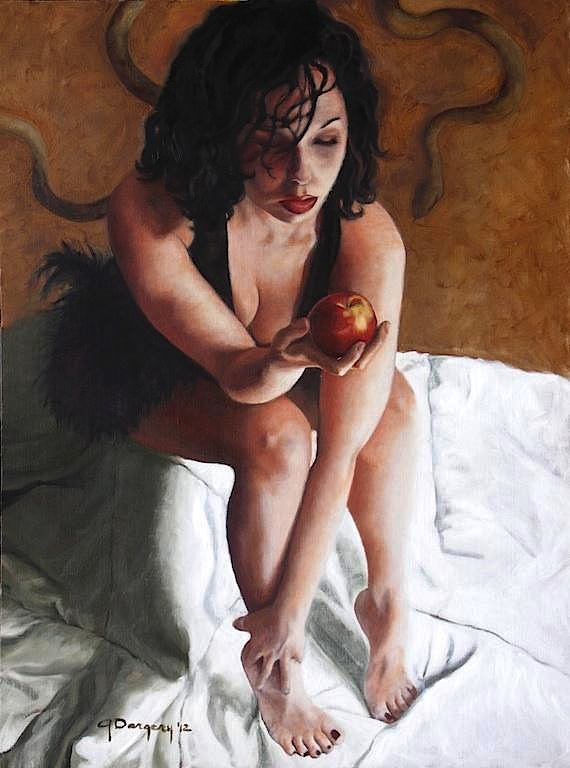
"Eve" by Galina
Dargery (2013)
❖❖❖
IN THIS ISSUE
WHAT'S NEW IN MIAMI?
BY JOHN MARIANI
R.I.P. CLARISSA DICKSON WRIGHT
By John Mariani
NEW YORK CORNER
DAVIO'S Northern Italian Steakhouse
by John Mariani
NOTES FROM THE WINE CELLAR
THE NEW FACE OF BAROLO
by John Mariani
❖❖❖
WHAT'S NEW IN MIAMI?
BY JOHN MARIANI
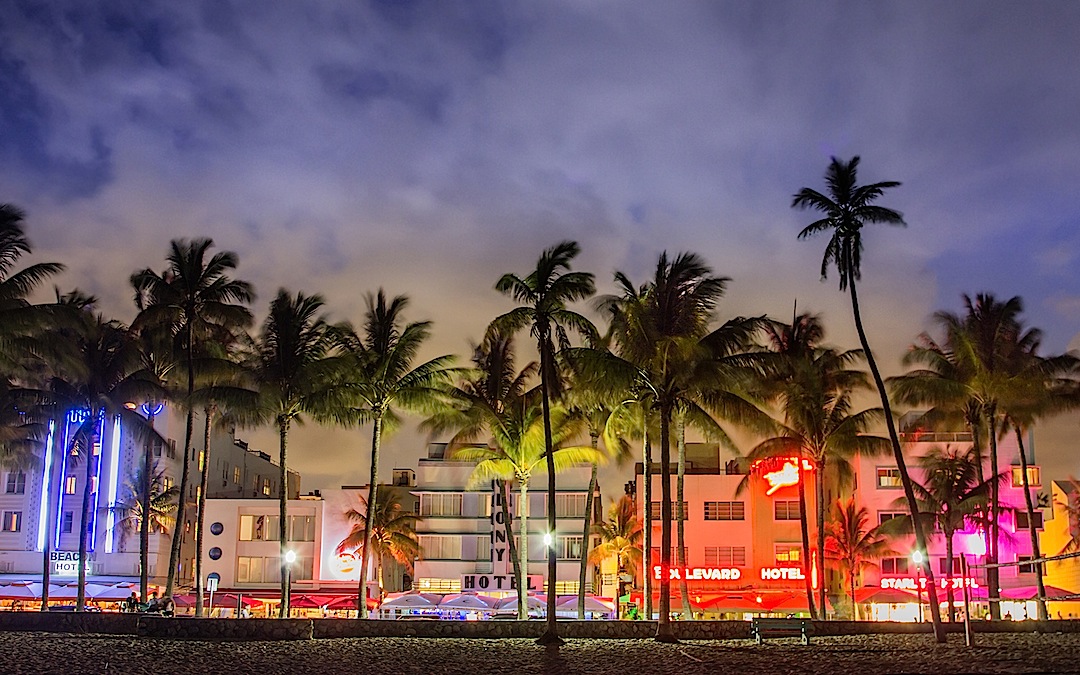
Ocean Boulevard, Miami Beach
Despite the pizzazz that still enlivens Ocean Boulevard on Miami Beach, a good deal of the gastro-excitement has shifted to other parts of Miami, not least the Design District, which is quickly becoming a destination for tourists as well as those looking to decorate their condos. Here are some of the most enticing new restaurants in the sun-kissed city right now, both on and off the Beach.
MC KITCHEN
4141 NE 2nd Avenue
305-456-9948
http://mckitchenmiami.com
 Quick:
name a great Italian restaurant in Miami. No?
Okay, how about a real good one? Take your time.
Nothing? Then here’s the
exciting news: MC Kitchen is not just the best and
best looking Italian
restaurant in Miami, it’s one of the best in America
right now.
Quick:
name a great Italian restaurant in Miami. No?
Okay, how about a real good one? Take your time.
Nothing? Then here’s the
exciting news: MC Kitchen is not just the best and
best looking Italian
restaurant in Miami, it’s one of the best in America
right now.
It’s hard to imagine an Italian restaurant in Miami having partners with better iambic names than Chef Dena Marino and Brandy Coletta. Dena’s national repute comes from working with Michael Chiarello at Tra Vigne in Napa Valley, then at Ajax Tavern in Aspen, where her lusty style of Italian cooking fit like a ski glove in the town’s Rocky Mountain chic.
Brandy, a grad of U of M and
a business developer who
worked on two Presidential campaigns, has a canny
sense of South Florida style,
shown in MC Kitchen's clean, stripped down
décor befitting its Design District
location, starting with gauzy curtains hung from a
16-foot ceiling, polished
wood paneling, a bar backed 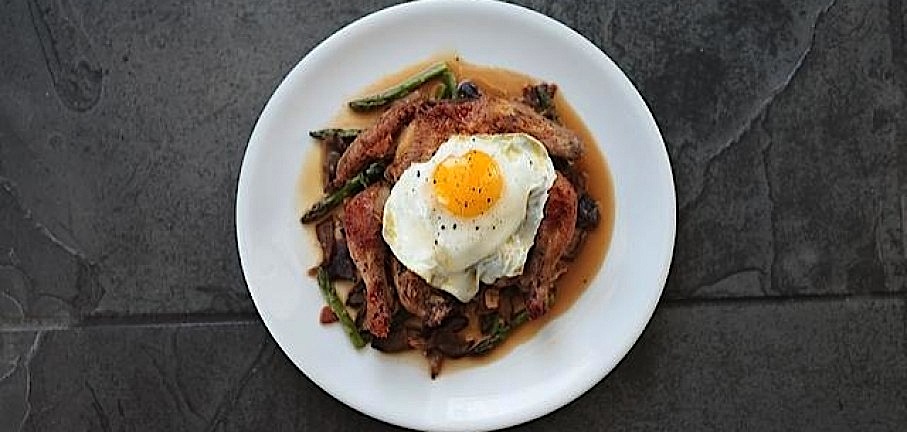 in chrome and mirrors, and
a white marble counter
at the stainless steel open kitchen. Even the liquor
and wine bottles seem
artfully placed on glass shelves to harmonize with
the rest of the décor.
in chrome and mirrors, and
a white marble counter
at the stainless steel open kitchen. Even the liquor
and wine bottles seem
artfully placed on glass shelves to harmonize with
the rest of the décor.
What distinguishes MC’s cooking is its elemental simplicity--the first rubric of Italian cuisine, adapted by Dena Marino with all the gusto she can muster in a dish like her pappardelle of spring ramps and “forever braised” pork ragù, and her crisp, charred pizzas topped with broccoli di rabe, sausage, fontina and caramelized onions. Miami being a hot weather city, she lightens up the menu with a juicy mahi mahi with arugula, licorice-like fennel, tiny, rare Ligurian Taggiasche olives, and tangy orange vinaigrette.
Her food and Coletta’s savvy coalesce in a sophisticated balance rare in a sunny city where glitz too often trumps good taste.
OAK TAVERN
35 NE 40th Street
786-391-1818
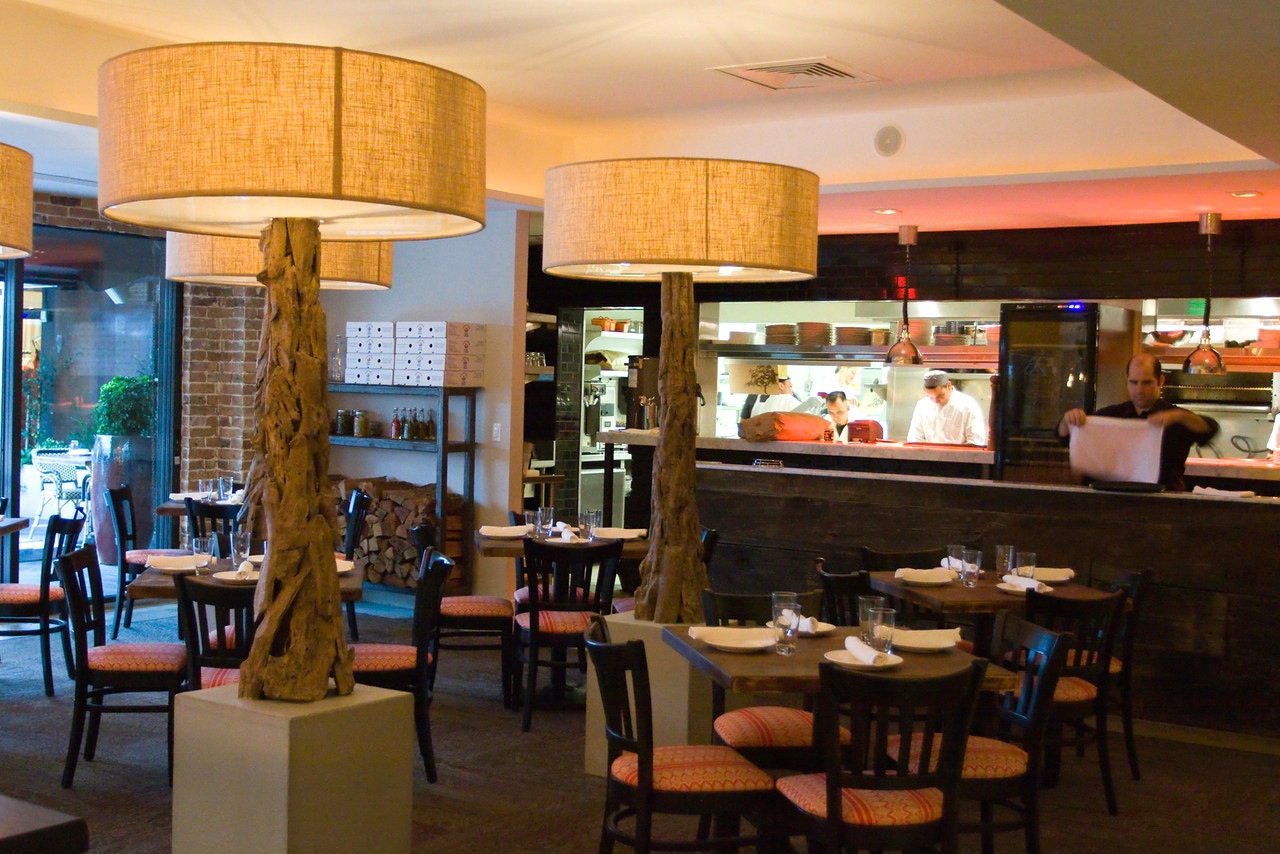 This
is another Design
District restaurant whose previous occupant, Pacific
Time, was much heralded as
among the more innovative restaurants of its day.
Oak Tavern owes its name to a
huge and ancient oak tree on the premises, and it's
more down to earth than its
swanky predecessor, both in its décor and its
menu, which pretty much has
something for everyone. It’s got a big, long
friendly bar, roomy leather
banquettes, brick walls and tables made from
reclaimed wood, with a large
communal table on wheels near the entrance. Of
course, this being Florida,
there is ample space outside.
This
is another Design
District restaurant whose previous occupant, Pacific
Time, was much heralded as
among the more innovative restaurants of its day.
Oak Tavern owes its name to a
huge and ancient oak tree on the premises, and it's
more down to earth than its
swanky predecessor, both in its décor and its
menu, which pretty much has
something for everyone. It’s got a big, long
friendly bar, roomy leather
banquettes, brick walls and tables made from
reclaimed wood, with a large
communal table on wheels near the entrance. Of
course, this being Florida,
there is ample space outside.
Chef David Bracha (below)
separates
his menu into small plates,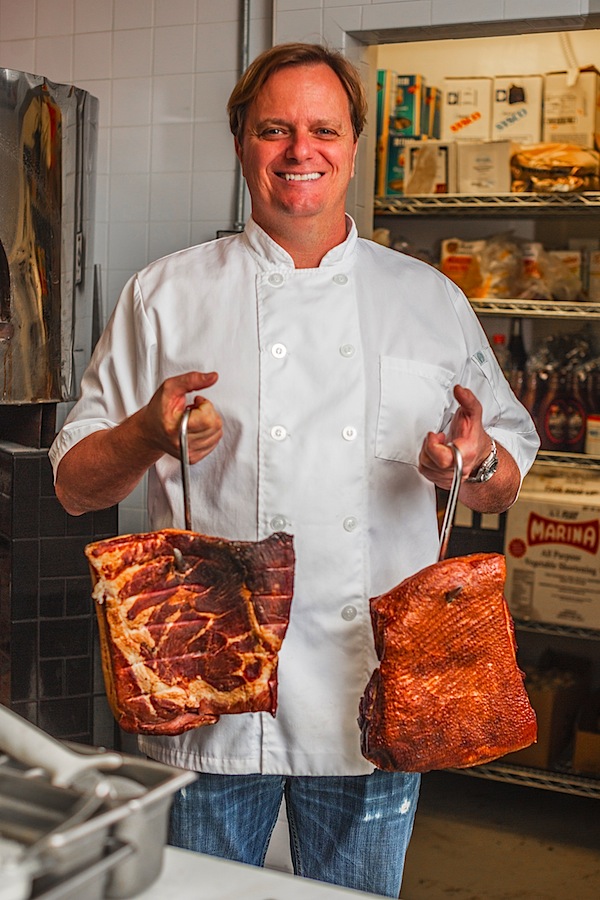 pastas and
pizzas, large plates, charcuterie,
cheese and sides, and there’s plenty of everything,
which means not everything
is going to be of equal value. I was really
won over by black grouper
with an octopus-romesco stew ($26) and by a
snapper filet with toasted
farro, spring vegetables and pistou ($25).
Suckling pig ($24)--a regular
item here--was crisp of skin and velvety of flesh,
served with hearty braised
lentils, mustard fruit and a smoked jus.
pastas and
pizzas, large plates, charcuterie,
cheese and sides, and there’s plenty of everything,
which means not everything
is going to be of equal value. I was really
won over by black grouper
with an octopus-romesco stew ($26) and by a
snapper filet with toasted
farro, spring vegetables and pistou ($25).
Suckling pig ($24)--a regular
item here--was crisp of skin and velvety of flesh,
served with hearty braised
lentils, mustard fruit and a smoked jus.
I wasn’t enamored of the bland duck pizza with fontina and truffle ($15) or by the unconvincing St. Louis smoked ribs ($14)--there’s good reason why barbecue places are only barbecue places--but the boquerones with roasted peppers, kale, and ricotta ($6) are addictively good, and for dessert, if they have the pineapple upside-down cake, order it before they run out. Each day there is a special, like short rib pho or wood-grilled goat, all very modestly priced.
The wine list is short
and
unimpressive, but there’s a serious attitude towards
good artisanal beers.
Open for lunch Mon.-Fri., nightly for dinner.
TONGUE & CHEEK
431 Washington Avenue
305-704-2900
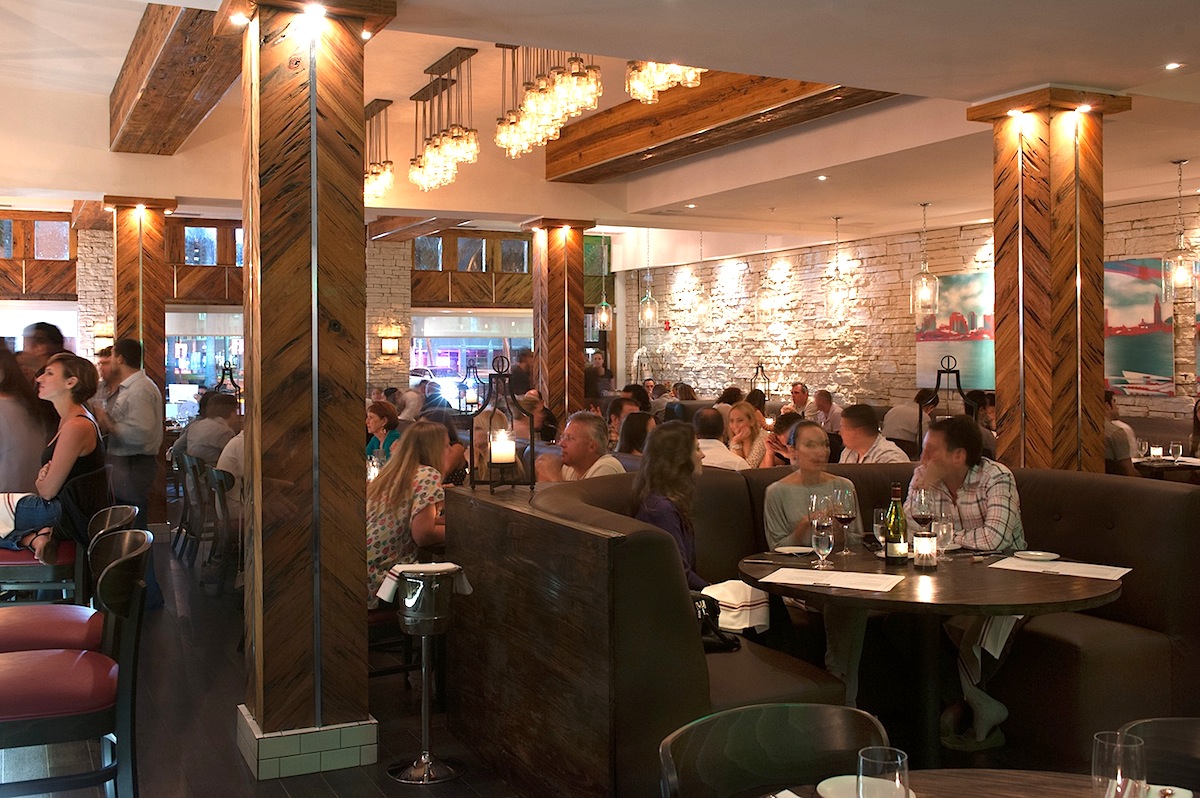 The
name is forgivably
duplicitous, for while you will find beef cheek on
the menu, I didn’t see any
tongue; by the same token, the name implies this is
a fun, drop-in kind of
place with serious food, from charcuterie and
cheeses to generous main courses,
all served by a chef, Jamie DeRosa, with a very
long, very fine résumé that
includes working with well-known chefs Allen Susser,
Wolfgang Puck, Mark Peel,
Joachim Splichal, and Geoffrey Zakarian.
Together with fellow industry
veteran Michael Reginbogin, he opened the 150-seat
Tongue & Cheek on South
Beach.
The
name is forgivably
duplicitous, for while you will find beef cheek on
the menu, I didn’t see any
tongue; by the same token, the name implies this is
a fun, drop-in kind of
place with serious food, from charcuterie and
cheeses to generous main courses,
all served by a chef, Jamie DeRosa, with a very
long, very fine résumé that
includes working with well-known chefs Allen Susser,
Wolfgang Puck, Mark Peel,
Joachim Splichal, and Geoffrey Zakarian.
Together with fellow industry
veteran Michael Reginbogin, he opened the 150-seat
Tongue & Cheek on South
Beach.
The menu is not unlike Oak Tavern’s, though smaller and better focused, starting off with appetizers like bruschetta of heirloom tomatoes with Boursin-style cheese ($9), and finger foodie lettuce wraps of crispy pig’s ears with orange and salted peanuts ($14).
DeRosa
picks up plenty of flavors from the most sensible
match-ups, like grilled skirt
steak with crème fraîche tater tots, maiitake
mushrooms and Cerignola olives
($33), and his juicy fried chicken comes with
pickled red cabbage, cheddar, a
delightful bacon biscuit and hollandaise shot
through with Tabasco ($24).
Shortribs get a Moroccan couscous treatment,
with feta and grilled Indian
naan bread
($34). And he’s
particularly proud of his poutine ($12), the
Canadian national dish here
interpreted as braised beef, cheddar and pastrami
spiced fries (right)--a
lot better
than most poutines I’ve had north of the border.
Ricardo
Torres
does some fine desserts, not least Norman’s Key lime
pie (in homage to
Florida chef Norman van Aken, I suspect), and 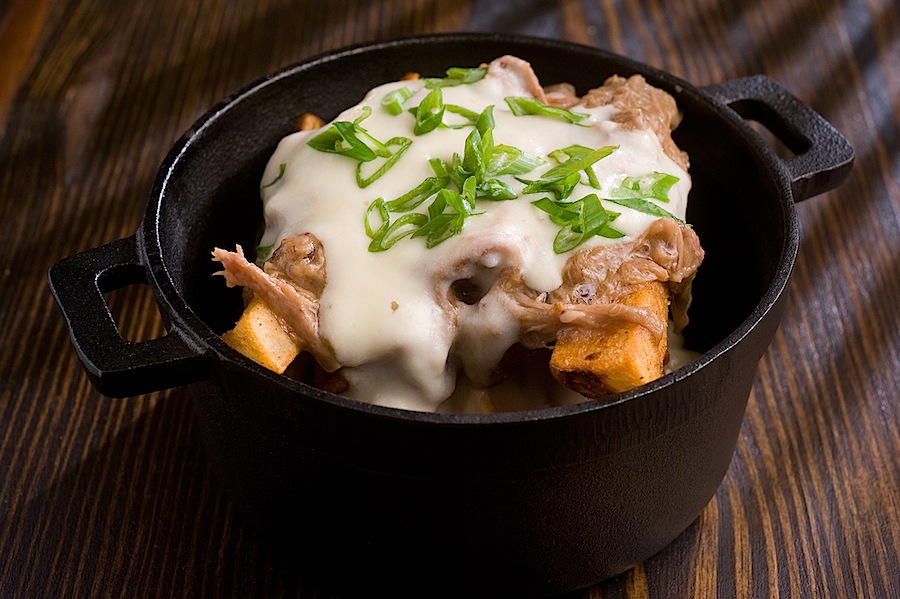 a Cracker
Jack milkshake and
Almond Joy bar that is sure to make your head
waggle.
a Cracker
Jack milkshake and
Almond Joy bar that is sure to make your head
waggle.
The place is big and wide, rich in wood and subway tiles, with views of the Miami skyline painted as a mural. It’s a lot of fun, though the music can get way too loud, and there’s hardly a dish on the menu that will leave you hungry.
Dinner served nightly.
Photos by
David Durbak
 DOLCE
DOLCE
Gale South Beach Hotel
1690 Collins Avenue
786-975-2550
http://www.dolceitalianrestaurant.com
Pedigree
counts
when it comes to Italian food, and Chef Paolo
Dorigato has a good one:
born in Trento, he picked up his American mojo at
restaurants like Le Cirque,
Osteria del Circo, and Cipriani Wall Street in New
York before coming to Miami,
where he is doing some authentic cucina
italiana in a refined, sleek dining room that
could very well be on Milan’s
fashion street, Via Montenapoleone.
Like MC Kitchen, Dolce brings a higher level of
Italian cuisine to the city and certainly to the
Beach.
By
all
means begin with selections from the mozzarella bar
with artisanal
meats
and vegetables ($14-$26). There are pizzas
($13-$17) listed, too, but I
found them too trendily thin in the crust, without
the proper chewiness. Pastas
include an excellent short rib ravioli in a richly
reduced Barolo wine sauce
($$22) and a very tasty pappardelle
alla
bolognese ($20), although it’s more a meat and
tomato sauce than an
authentic rendering alla bolognese.
Spaghetti and meatballs ($23) are a nice
choice, now becoming again as
popular as pasta primavera used to be.
artisanal
meats
and vegetables ($14-$26). There are pizzas
($13-$17) listed, too, but I
found them too trendily thin in the crust, without
the proper chewiness. Pastas
include an excellent short rib ravioli in a richly
reduced Barolo wine sauce
($$22) and a very tasty pappardelle
alla
bolognese ($20), although it’s more a meat and
tomato sauce than an
authentic rendering alla bolognese.
Spaghetti and meatballs ($23) are a nice
choice, now becoming again as
popular as pasta primavera used to be.
Dorigato is at his finest with seafood: a roasted branzino ($34) was perfect, served with cous cous, baby carrots and cherry tomato sauce (right), and the seared red snapper ($27) with leeks, asparagus and olives was simple and delicious in every moist morsel. I did not care at all for his veal milanese with Tuscan fries.
The best of the desserts is his budino pudding with salted caramel and a chocolate chip cookie for good measure, followed by a light panna cotta with mango puree and strawberry compote.
Dolce’s wine list is not particularly comprehensive but solidly chosen in both white and red categories.
Dolce serves breakfast, lunch and dinner daily
THE CYPRESS ROOM
3260 NE Second Avenue
305-520-5197
 No
one is a bigger fan than I of Chef Michael Schwartz,
whose fabulous Michael
Genuine Food & Drink was the first big opening
salvo in the Design District
a few years back. Indeed, the restaurant rang up so
many awards, including my
own as one of the “Best New Restaurants of the Year”
in Esquire, that money men came calling
and convinced Schwartz to open
a lot more places very quickly, including another
Michael’s Genuine in the
Cayman Islands, dining rooms on two Royal Caribbean
cruise ships, Harry’s
Pizzeria, as well as a line of beers. (His
Restaurant Michael Schwartz in
The Raleigh Hotel is in limbo with the recent sale
of the property.)
No
one is a bigger fan than I of Chef Michael Schwartz,
whose fabulous Michael
Genuine Food & Drink was the first big opening
salvo in the Design District
a few years back. Indeed, the restaurant rang up so
many awards, including my
own as one of the “Best New Restaurants of the Year”
in Esquire, that money men came calling
and convinced Schwartz to open
a lot more places very quickly, including another
Michael’s Genuine in the
Cayman Islands, dining rooms on two Royal Caribbean
cruise ships, Harry’s
Pizzeria, as well as a line of beers. (His
Restaurant Michael Schwartz in
The Raleigh Hotel is in limbo with the recent sale
of the property.)
On
top
of all that he opened The Cypress Room last year in
the Design District, a
small, clubby dining venue that has the ambiance of
one from the 1950s, with a
wood-burning grill as the featured cooking
implement. This means the
cooking is very simple, which I usually applaud, but
I found the food overall
to lack any real excitement, and there were some
problems with pacing and the
temperature of the food. Royal red shrimp
($23) with cucumber, coconut,
lime and puffed rice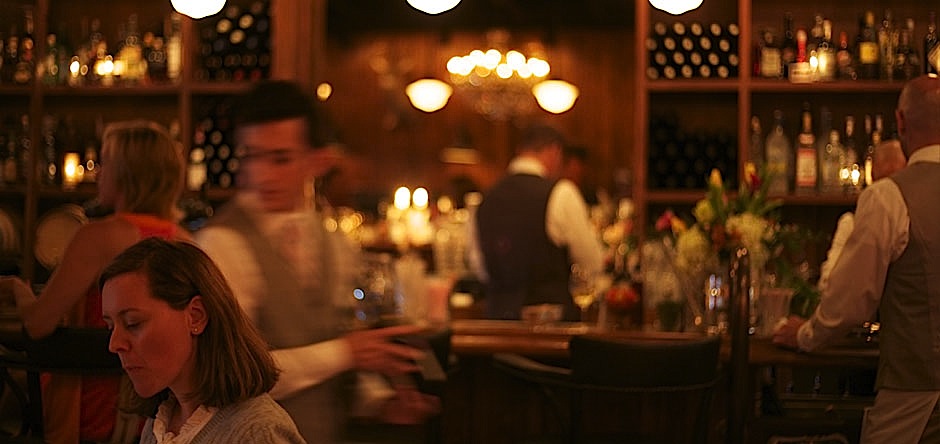 was pleasant enough, but frog’s legs
($21) with capers and
potato definitely needed a dose of garlic. An onion
soup ($17) was
actually a thin chicken broth with a pullet egg and
a little Gruyère cheese.
was pleasant enough, but frog’s legs
($21) with capers and
potato definitely needed a dose of garlic. An onion
soup ($17) was
actually a thin chicken broth with a pullet egg and
a little Gruyère cheese.
The best of the entrees was a superb bouillabaisse Florida style ($37) with aromatic fennel and plenty of good olive oil, and I sort of enjoyed a leg of lamb in broth ($46). A not very big antelope chop ($46) came out tepid and bland. Thrice-Cooked fried potatoes ($10) were absolutely wonderful and I wish I'd ordered more. There is also, as it follows the fashion of the day, a côte de boeuf I didn’t try, at a whopping $139 for two.
Of the desserts a Pavlova cake had a meringue crust that was too hard when it should have been crisp but yielding.
I hope that Michael Schwartz has not got too much on his plate to deal with. He's immensely talented, but The Cypress Room does not show that off at his best. Nor do management contracts on cruise lines.
The Cypress Room is open for lunch Mon.-Fri., for
dinner Mon.-Sat.
❖❖❖
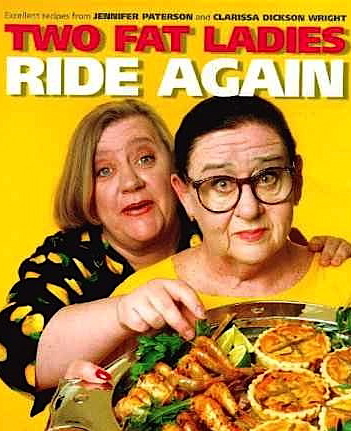 This
week the last of the “Two
Fat Ladies" died: Clarissa Dickson Wright followed
the passing away of
her colleague Jennifer Patterson (on the right in the
photo)
in 1999, leaving everyone who loves food very
much to mourn two of the
great teachers of English cookery.
This
week the last of the “Two
Fat Ladies" died: Clarissa Dickson Wright followed
the passing away of
her colleague Jennifer Patterson (on the right in the
photo)
in 1999, leaving everyone who loves food very
much to mourn two of the
great teachers of English cookery.
The
couple filmed four BBC series that became
internationally beloved for their
quirky disobedience to any trends or fashions in
cuisine. Riding
around the English
countryside in their sidecar motorcycle, they would
arrive at a large stone
house, enter a spacious well-equipped antique
kitchen and begin preparing old-fashioned British
fare underpinned by classical French technique.
Long before Paula Deen
embarrassed herself on American TV with her
near-pornographic overuse
of butter, the Two Fat Ladies were ladling cream and
butter, suet and lard into
pastry crust, wrapping meats in caul fat and streaky
bacon, and absolutely
reveling in the decadence of it all in the name of
delicious, good flavor. They knew exactly what
they were doing, without so much as a smirk.
Wright
had once been an attorney, battled
and defeated alcoholism, worked as a cook and
managed a London book shop, ran a
catering business and luncheon club, and became a
guild butcher—a rarity for a
woman then. She had run through a
large
inheritance, went bankrupt more than once, and grew
fat. But
when asked if she minded the TV
show being called “Two Fat Ladies,” she replied, “If
you're fat you're fat. I
hate this modern-day political correctness, that you
don't call things by their
proper name."
Her persona, which
was only slightly less eccentric than her partner’s,
was that 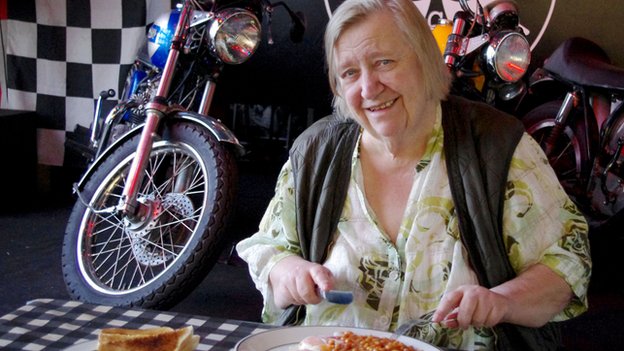 of a formidable and
brazenly large woman, laughing heartily, tongue in
cheek, lecturing, cajoling,
and saying outrageous things like, “you really want
to get it well greased. Did
you see `Last Tango in Paris?’ Something like that.” She raged at health food and
never imagined too much of
something could be anything but better.
of a formidable and
brazenly large woman, laughing heartily, tongue in
cheek, lecturing, cajoling,
and saying outrageous things like, “you really want
to get it well greased. Did
you see `Last Tango in Paris?’ Something like that.” She raged at health food and
never imagined too much of
something could be anything but better.
The two women had
actually never met before they went on the air in
1996, so the show was really an act, one
playing off the other, Jennifer r-r-r-rolling
her r’s
and Clarissa making
off-color jokes as the kitchen filled up with
wonderful smells only imaginable by
the TV viewer. The show met every
expectation of those who like their Brits dotty, and
Wright and Patterson
played it all to the hilt—fiercely intelligent but
seeming to be completely loopy. They were the polar
opposites of the frenzied BBC sitcom characters
Edina Monsoon and Patsy Stone on "Absolutely
Fabulous." The Fat Ladies never quite
winked at the camera
but you knew they were having a ball, and it came
through the airwaves like the
aroma of vanilla and caramelized sugar.
Only 66
when she
died, Wright left behind a legacy of British humor
and presented a powerful argument for
saving the cookery of another age, one now eclipsed
by a modern cuisine more
about style than good taste. Wright
and Patterson are now both gone,
and in their place we have the rantings of Gordon
Ramsay in fully
rehearsed explosions
of dyspeptic rage where
once the Two Fat Ladies--everyone's crazy English
aunties-- gave us such good-natured and genteel instruction
in the true joy of
cooking and eating.
❖❖❖
by John Mariani
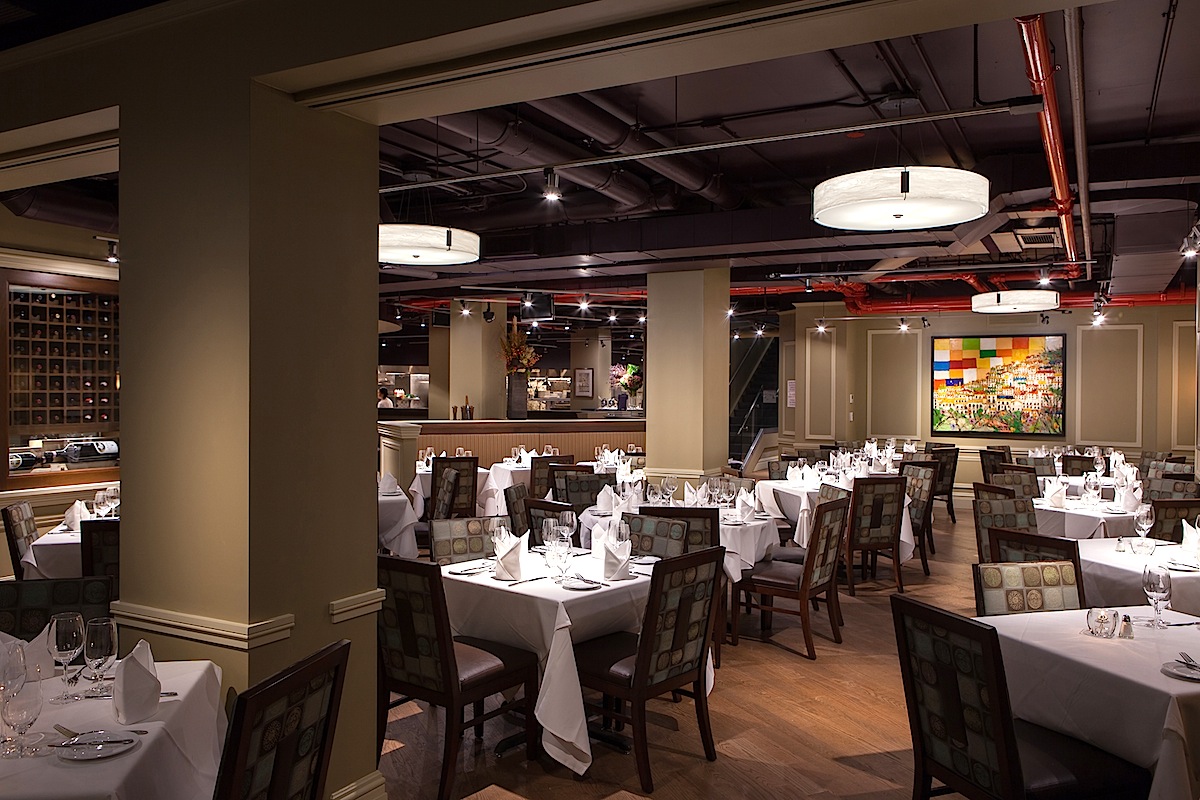 Davio'S
Davio'S
NORTHERN ITALIAN STEAKHOUSE
451 Lexington Avenue (near 46th Street)
212-661-4810
davios.com/nyc
Monday night in NYC. Bitter cold: 21 degrees with wind chill factor down to 10. Nobody on the streets. Not a night to go out to dinner. Yet, upon entering the three-month-old Davio's, I found that it seemed everyone who did go out to dinner that night was in the restaurant, which was doing booming business. Which goes to prove that: New Yorkers are a tough bunch; steakhouses make sense anywhere; and Davio's, a small steakhouse chain, has plenty of out-of-town regulars and new fans.
Since opening the original Davio’s in Boston, owner Steve DiFillippo has had considerable success capitalizing on the Italian steakhouse theme, with branches in Foxborough and Lynnfield, MA, Philadelphia, and Atlanta. When I heard he was opening in NYC, I arched an eyebrow, not because Davio’s food could not compete with the city's better steakhouses, but because I wasn’t sure New Yorkers would embrace a Boston clone, especially in a neighborhood overrun with steakhouses.
Obviously,
I had no need to worry. For,
like several of the new steakhouses around town,
like NYY Steak, Del Frisco’s
Grill, and Costata, 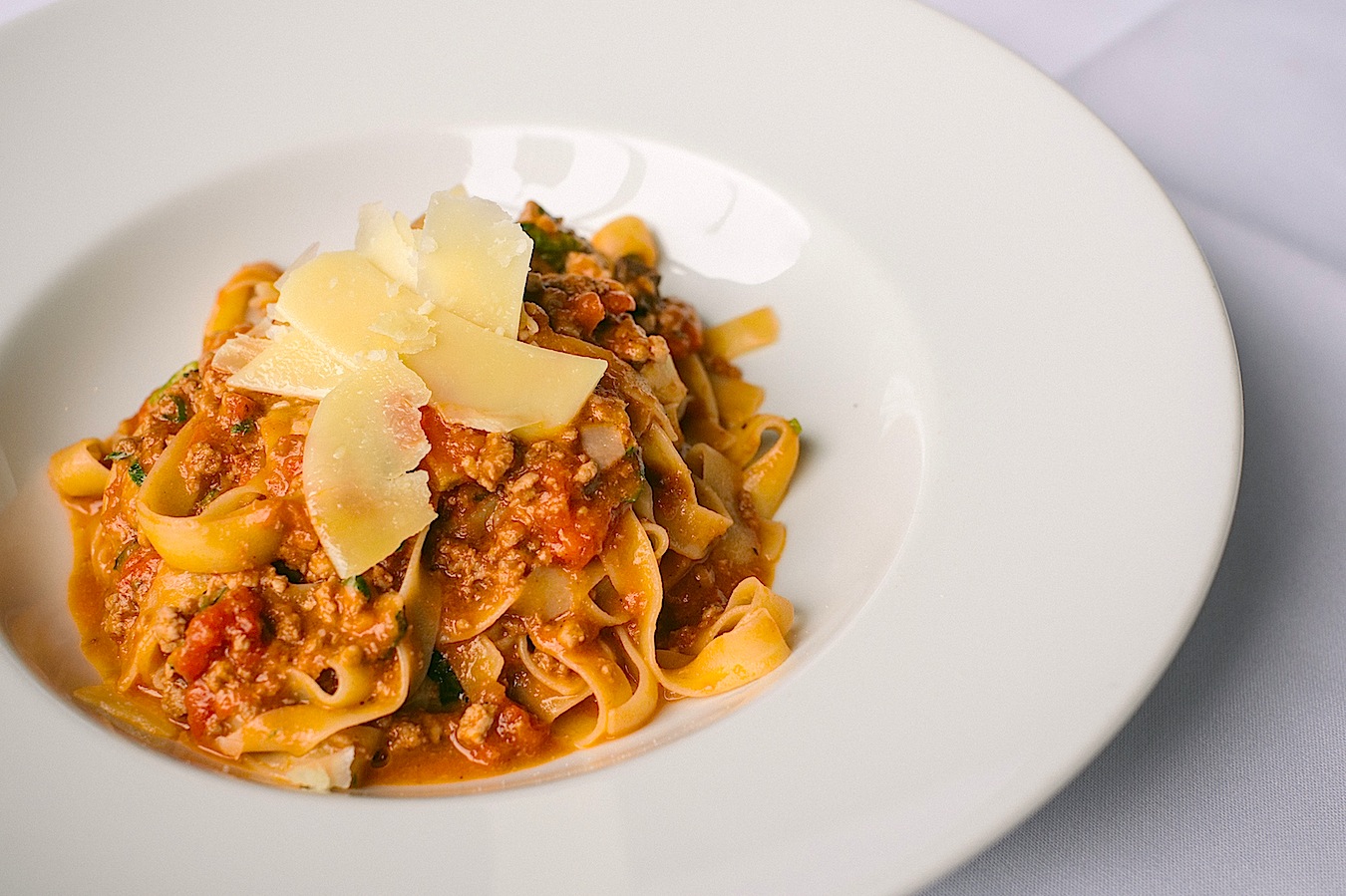 the formerly entrenched attitude
problem at the door of
older Manhattan steakhouses is nowhere part of the
reception or service at
Davio's, which is subterranean.
People who come down the stairs here are
welcomed warmly and
treated to a robust hospitality that most patrons
come to cherish.
the formerly entrenched attitude
problem at the door of
older Manhattan steakhouses is nowhere part of the
reception or service at
Davio's, which is subterranean.
People who come down the stairs here are
welcomed warmly and
treated to a robust hospitality that most patrons
come to cherish.
Of course, the addition of the title “Northern Italian Steakhouse” to the Davio’s name means that the menu will cast a wider net than most others in the field. Indeed, Davio’s menu is somewhat unwieldy, with many more dishes than is necessary. Chef Chad Brown, a native of Seoul, South Korea, has a solid résumé that includes stints at NYC’s Del Posto, CATCH, and Bond 45, and he’s been given some leeway to create his own dishes that you won’t find at other Davio’s branches.
It’s a good looking place, broken into sections, with a bar with its own menu, a semi-open kitchen, well-set and well-separated tables, and good modern artwork, all of it breaking away from the clichés of steakhouses with wood floors, yellowed walls, and dark wainscoting.
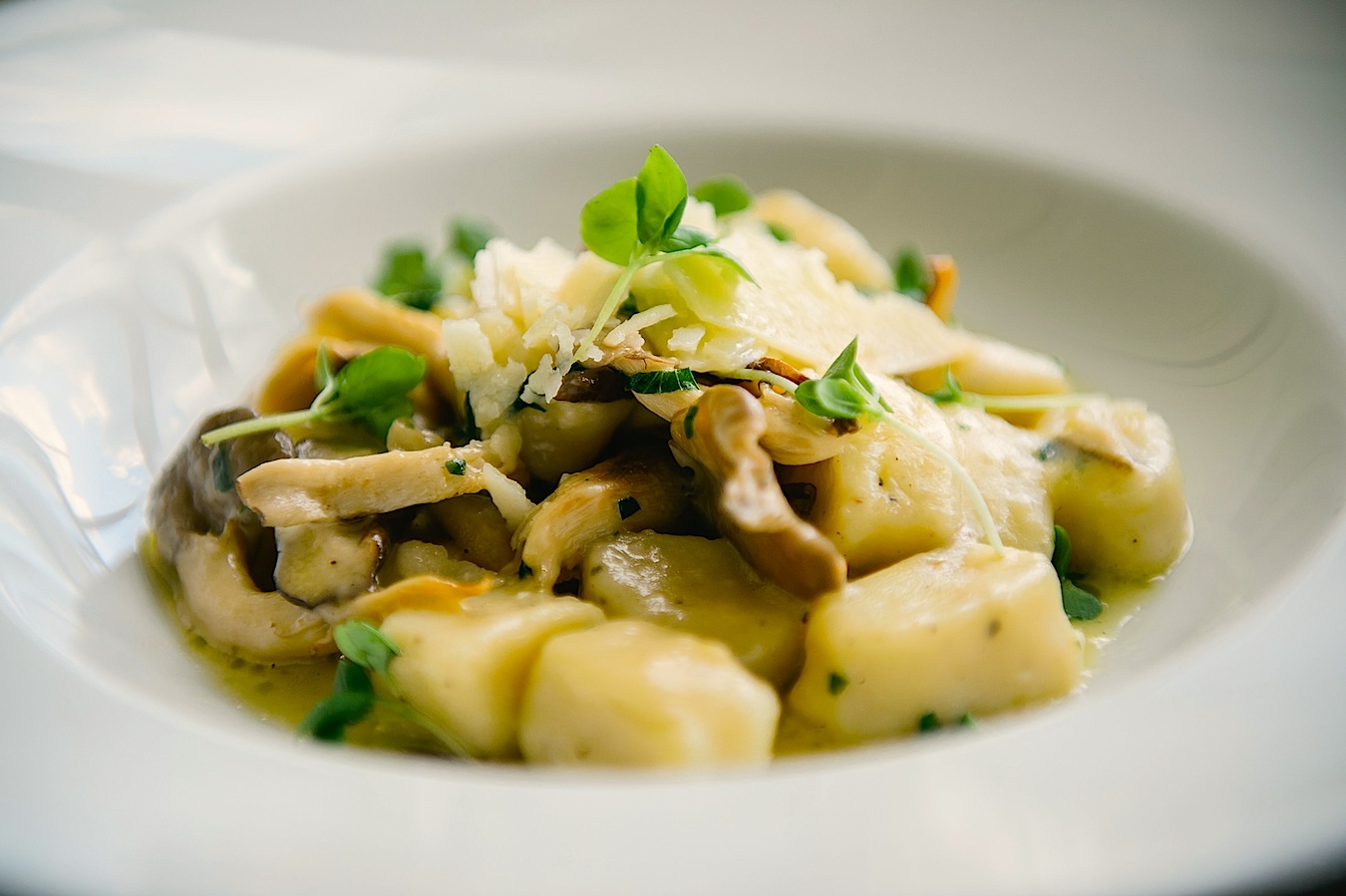 The best
dish of our evening at Davio’s was the
very first--crisp chicken livers with a Port
balsamic glaze, toasted pine nuts,
and crisp spinach ($12), the kind of dish that,
once tasted, will change your
idea of chicken livers forever. Pan-seared foie
gras took beautifully to fig
and ricotta-stuffed gnocchi in a lush Vin Santo
sauce ($21). American
Kobe meatballs with tomato sauce and caciocavallo
cheese ($12) were very good,
though I’m not sure they were much improved by
adding Kobe beef to the mix.
The best
dish of our evening at Davio’s was the
very first--crisp chicken livers with a Port
balsamic glaze, toasted pine nuts,
and crisp spinach ($12), the kind of dish that,
once tasted, will change your
idea of chicken livers forever. Pan-seared foie
gras took beautifully to fig
and ricotta-stuffed gnocchi in a lush Vin Santo
sauce ($21). American
Kobe meatballs with tomato sauce and caciocavallo
cheese ($12) were very good,
though I’m not sure they were much improved by
adding Kobe beef to the mix.
There are six pasta dishes on the menu and every one I tried was first rate, including spaghettini with abundant lobster, tomatoes, and basil ($34). Capellacci come with slowly roasted squash, Amaretti cookie crumble and a rich walnut cream sauce ($27), while potato gnocchi (left) with mushrooms, basil and white truffle oil ($28) were fought over at our table.
I have chided the Davio’s people for a lack of authenticity in their “bolognese” sauce, but their tagliatelle in a braised veal, beef, pork and tomato sauce ($28) would win over anyone by any name whatsoever. It’s delicious.
This is a
steakhouse, but we enjoyed a
pan-seared halibut whose snow white flesh was well
accompanied by pancetta
bacon, broccoli di 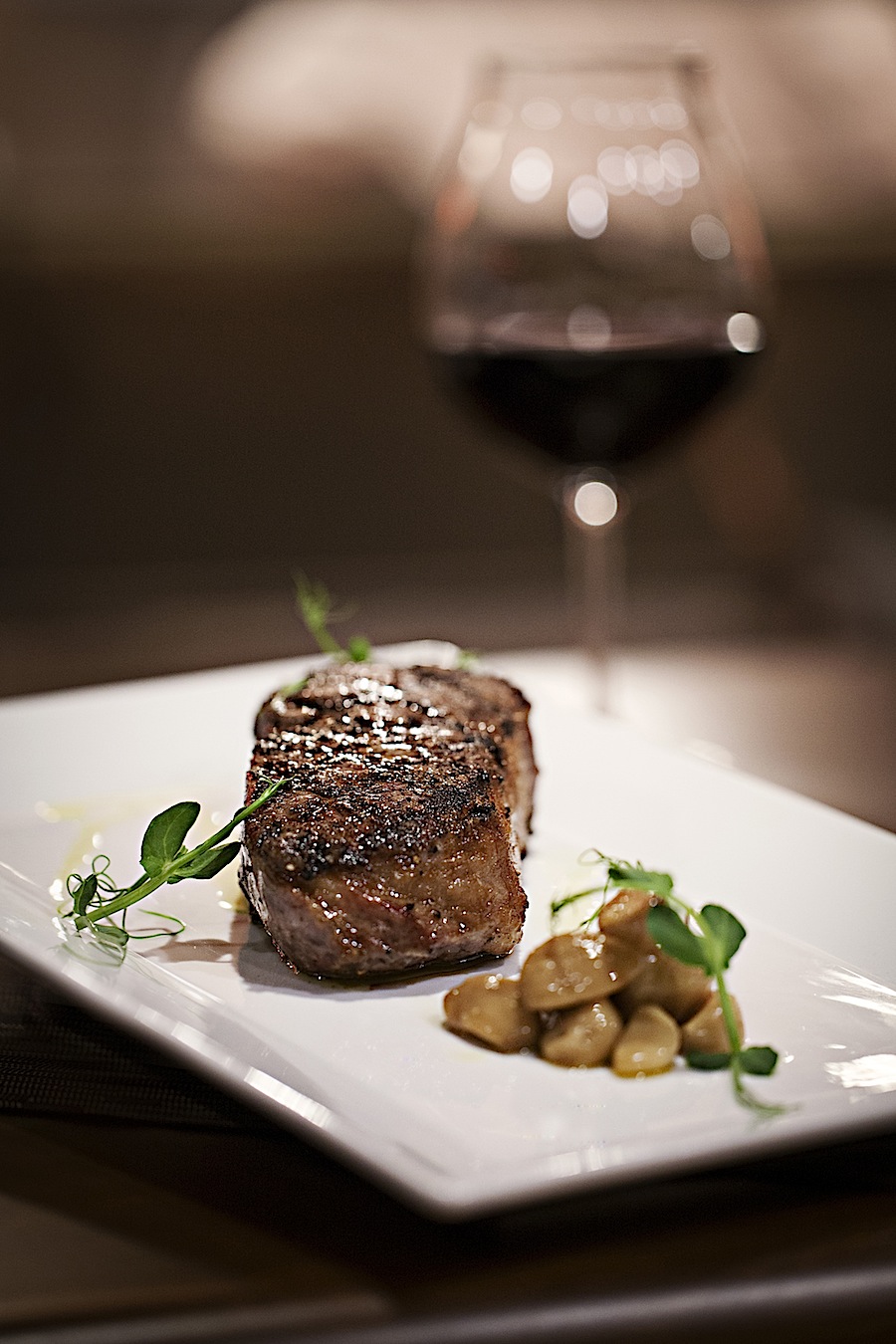 rabe and
the
sparkling addition of tangerine, all in an olive
oil and anchovy bagna cauda
bath ($38).
rabe and
the
sparkling addition of tangerine, all in an olive
oil and anchovy bagna cauda
bath ($38).
The beef dishes come from unassailable sources, including a
fine center cut filet ($37) with more flavor than expected of this cut (right), and a finely crusted NY sirloin ($48), cooked perfectly, with a deep rich flavor only meat this good can achieve. Side sauces like blood orange citron, salsa verde, truffle tarragon butter and Davio’s Steak Sauce are available.
In the face of such quality meats, it was puzzling, then, to find an Australian rack of lamb (with roasted lamb neck, escarole ragu, and cannellini beans) at $45 on the menu--especially since the Atlanta Davio’s serves far superior Colorado lamb (which is infinitely better than the New Zealand lamb they serve in Philadelphia for $49). Davio’s NY’s nearby East Side competitors--Palm, Smith & Wollensky, Sparks, Michael
Jordan, and others--all serve American lamb for the same reason they serve American beef: superior quality.
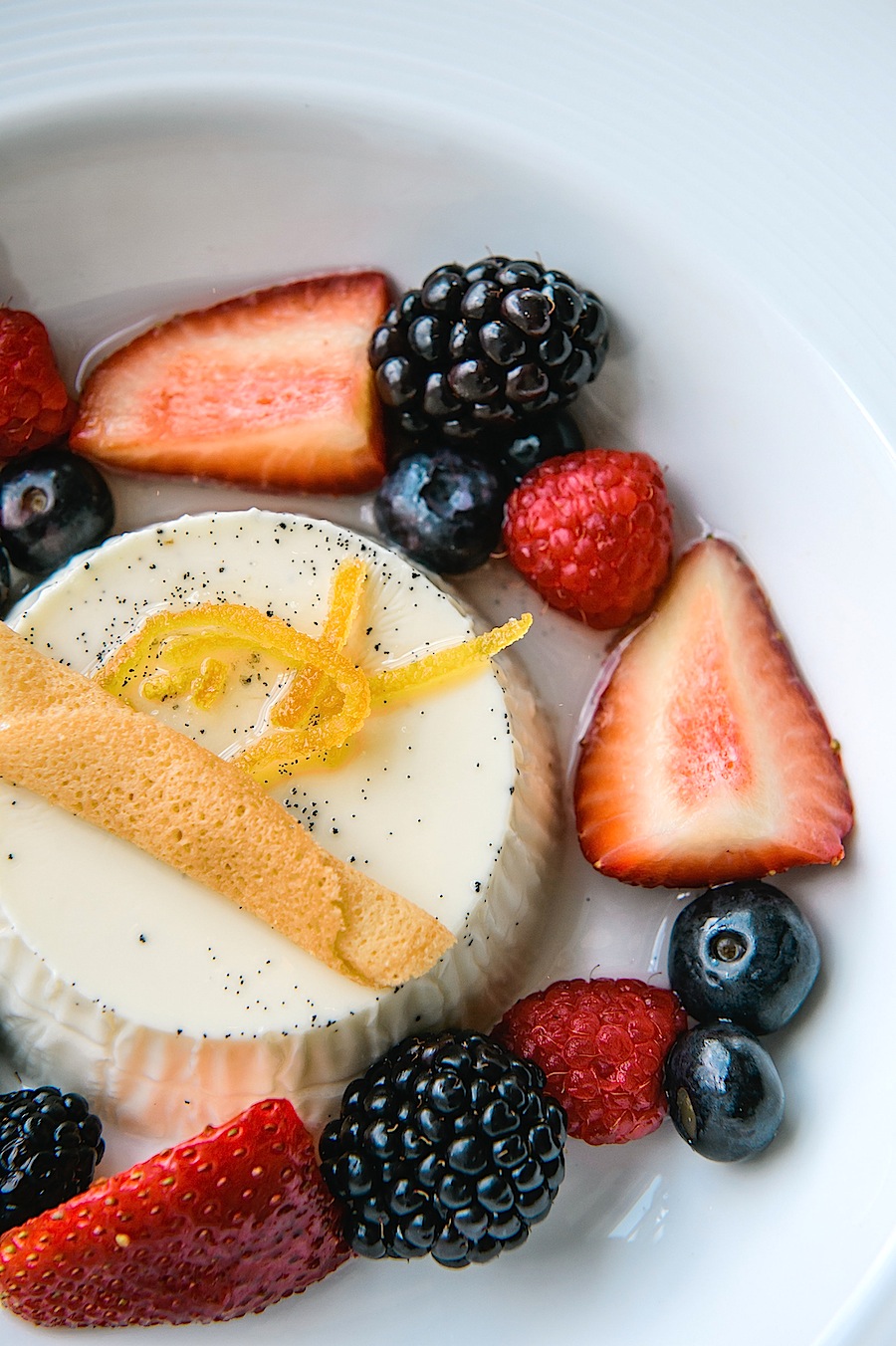 Side
dishes all ranked with the best around
town--buttermilk mashed potatoes, spinach alla romana,
spicy broccoli di rabe, and more, though it’s odd
they don't offer the usual French fries,
hashed browns or onion rings.
Side
dishes all ranked with the best around
town--buttermilk mashed potatoes, spinach alla romana,
spicy broccoli di rabe, and more, though it’s odd
they don't offer the usual French fries,
hashed browns or onion rings.
Desserts like panna cotta (right) are
generously proportioned to share, and the warm
chocolate cake is a fine one.
An added attraction is Davio’s proximity by one block to Grand Central Terminal, and breakfast is served every day. More important, in a neighborhood already rife with steakhouses, Davio’s is trying hard to attract a clientele that can count on true hospitality rather than the kind of favoritism that reigns at its competitors. They do so by offering a two-course $25 lunch and a three-course $38 dinner, Bar Menu, and, exclusive to the NYC branch, wines are half price on Sundays from 5 pm to 10 pm.
Davio’s serves breakfast daily, Lunch Mon.-Fri.,
Dinner nightly.
❖❖❖
THE NEW
FACE OF BAROLO
By
John Mariani
 It is by now a given among
connoisseurs that Italy’s Barolo wines are on a par
with the very finest wines of Bordeaux and Burgundy,
though there is something of a cold war going on
among Barolo producers in the region of Piedmont,
pitting strict traditionalists against a more
progressive
wing.
It is by now a given among
connoisseurs that Italy’s Barolo wines are on a par
with the very finest wines of Bordeaux and Burgundy,
though there is something of a cold war going on
among Barolo producers in the region of Piedmont,
pitting strict traditionalists against a more
progressive
wing.
Not that anyone there can fiddle too much with the basics, for under Italian wine laws Barolo must be made entirely from nebbiolo grapes from delimited zones within Piedmont, named after the towns set among 19th century vineyards. Barolo will always be a big, tannic red wine--called “noble”--and the government gives the wine its highest appellation, D.O.C.G., which means it is guaranteed to be among the highest quality wines in Italy. Indeed, if a vintage turns out to be low in quality, the Barolo vintners must label their product as simple “table wine.”
The
imbroglio among vintners in the present century
matches those who believe that Barolo must be made
tannic, with fermentation lasting up to two months
and aging done in huge old oak barrels called “tonneaux”
for many years, and, on the other side, a younger
generation that believes the old style robs the wine
of its fruit and takes far too 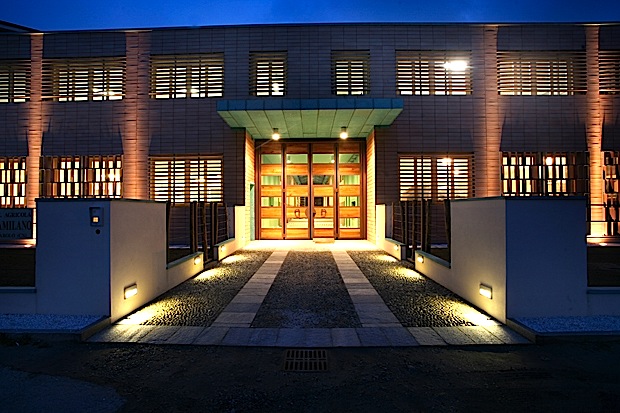 long to mature. These modern Barolos
are more commonly aged in smaller French barrels
called “barriques” and made of new wood.
That these are somewhat less weighty wines
than the traditional Barolos is generally true.
long to mature. These modern Barolos
are more commonly aged in smaller French barrels
called “barriques” and made of new wood.
That these are somewhat less weighty wines
than the traditional Barolos is generally true.
The problem for the consumer comes when confronted by so many new Barolo labels. Wine-Searcher.com shows 500 different Barolo labels on its website , and that’s only a partial list. And these producers want very much to sell to the U.S. market because interest here is very high.
“Americans who love wine really know a lot about them--more than many Europeans,” says Paolo Damilano, a fourth-generation winemaker at his family’s Piedmont estate, Damilano (right). “It’s difficult to sell Barolo in Italy because the Italians think of it as a special occasion wine, while Americans drink it as often as they wish to.”

The occasion I had to drink Damilano’s wines was at Ristorante Morini in New York when Guido was on a sales and media tour. “Sixty percent of our exports are to the U.S.,” he said over a plate of macaroni with tomato, onions and mozzarella. “Only fifty percent of our wines are actually sold in Italy.”
Paulo (on the right in photo) and his brother Guido, together with their father, Mario, date the family’s winery to 1890. Originally set on just 12 acres, it has been appended with holdings in the most prestigious zones, including La Morra, Casorzo, Serralunga, and others, all growing nebbiolo grapes, but each with a different expression of terroir in the wines.
One section, called Cannubi, is planted on a long hill above the town of Barolo, providing an ideal amount of sun and a perfect mixture of marl and sandstone soil for the grapes to prosper (below). Damilano’s Cannubi, from vines that date back five decades, is aged for two years in the traditional big oak barrels, and on its emergence in the market its tannins are tamed and its elegance pronounced, even with a high 15 percent alcohol. The fruit and acids are impeccably balanced and go very well with simple dishes and meats.
Damilano’s Barolo Brunate, made from grapes from
younger, albeit 30-year-old vines, is only 14
percent alcohol, after spending 24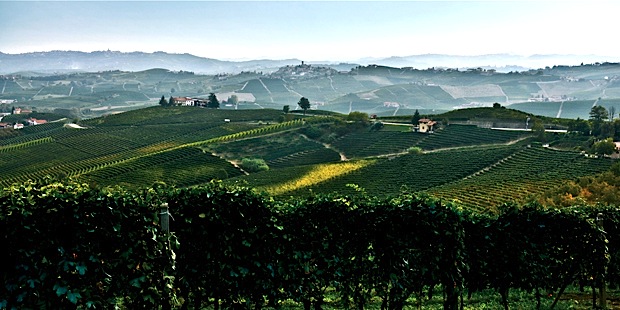 months in a succession of
new and old oak barrels. It has amazing
richness bound with complexities and nuance, and, if
one is willing to wait three to five years, it will
be a template for a middle style, between strict
tradition and progressivism.
months in a succession of
new and old oak barrels. It has amazing
richness bound with complexities and nuance, and, if
one is willing to wait three to five years, it will
be a template for a middle style, between strict
tradition and progressivism.
Damilano also
produces less expensive Piemontese wines like
Barbera d’Asti, Arneis, Nebbiolo and Chinato, but it
is on their Barolos that they stake their reputation
and on the American market where they are carefully
building it.
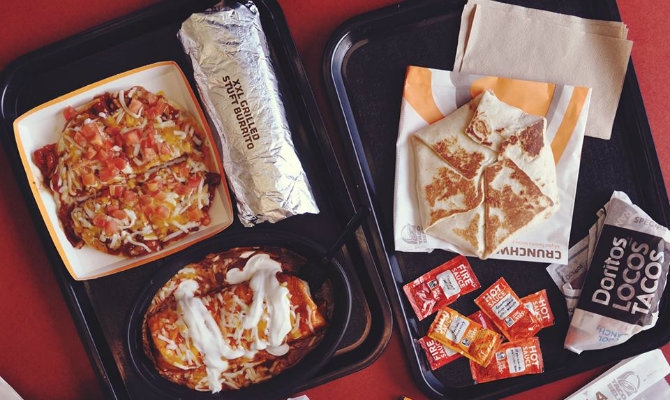 THERE WAS SOME THOUGHT ABOUT
WRAPPING THE WHOLE THING IN BACON THEN TOPPING
IT WITH FRENCH FRIES AND ROLLING IT INTO A
PEPPERONI PIZZA, BUT IT WAS NOT COST EFFECTIVE
THERE WAS SOME THOUGHT ABOUT
WRAPPING THE WHOLE THING IN BACON THEN TOPPING
IT WITH FRENCH FRIES AND ROLLING IT INTO A
PEPPERONI PIZZA, BUT IT WAS NOT COST EFFECTIVE
According to the Los Angeles Times, Taco Bell is testing a burrito and
quesadilla combination that rolls the contents of a
burrito inside a toasted quesadilla. Some of you might
recognize this exciting menu item as Taco Bell’s answer
to the Quesarito, a secret menu item from
Chipotle.
Taco Bell’s Quesarito options will include a beef,
shredded chicken or steak burrito with rice and sour
cream, wrapped in a grilled quesadilla. Depending on
your choice of meat, the test prices range from $1.99 to
$2.99.
REASON NO.
10: SOME OF THEM SEEM 
TO BE
SELF-HATING IN THE FIRST PLACE
"More people probably hate me than I realize. It's not
because I'm a bad person—although I am— but instead it's
because of my being a food writer. Chefs hate food
writers and they are right to hate them. Most of their
reasons are good ones; here are nine of them. By the
way, these apply to all food writers, but to critics in
particular, who are objects of special loathing to
chefs."—Josh Ozersky, "Nine Good
Reasons All Chefs Hate All Food Writers," Vice.com.
Any of John Mariani's
books below may be ordered from amazon.com.
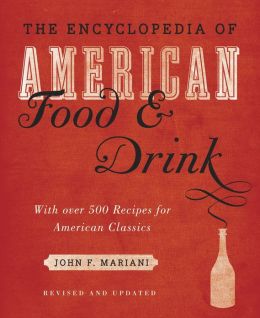 |
The Encyclopedia of American Food and Drink by John F. Mariani (Bloomsbury USA, $35) Modesty forbids me to praise my own new book, but let me proudly say that it is an extensive revision of the 4th edition that appeared more than a decade ago, before locavores, molecular cuisine, modernist cuisine, the Food Network and so much more, now included. Word origins have been completely updated, as have per capita consumption and production stats. Most important, for the first time since publication in the 1980s, the book includes more than 100 biographies of Americans who have changed the way we cook, eat and drink -- from Fannie Farmer and Julia Child to Robert Mondavi and Thomas Keller. "This book is amazing! It has entries for everything from `abalone' to `zwieback,' plus more than 500 recipes for classic American dishes and drinks."--Devra First, The Boston Globe. "Much needed in any kitchen library."--Bon Appetit. |
"Eating Italian will never be the same after reading John Mariani's entertaining and savory gastronomical history of the cuisine of Italy and how it won over appetites worldwide. . . . This book is such a tasteful narrative that it will literally make you hungry for Italian food and arouse your appetite for gastronomical history."--Don Oldenburg, USA Today. "Italian
restaurants--some good, some glitzy--far
outnumber their French rivals. Many of
these establishments are zestfully described
in How Italian Food Conquered the World, an
entertaining and fact-filled chronicle by
food-and-wine correspondent John F.
Mariani."--Aram Bakshian Jr., Wall Street
Journal.
"Equal parts
history, sociology, gastronomy, and just
plain fun, How Italian Food Conquered the
World tells the captivating and delicious
story of the (let's face it) everybody's
favorite cuisine with clarity, verve and
more than one surprise."--Colman Andrews,
editorial director of The Daily
Meal.com. "A fantastic and fascinating
read, covering everything from the influence
of Venice's spice trade to the impact of
Italian immigrants in America and the
evolution of alta cucina. This book will
serve as a terrific resource to anyone
interested in the real story of Italian
food."--Mary Ann Esposito, host of PBS-TV's
Ciao
Italia. "John Mariani has written the
definitive history of how Italians won their
way into our hearts, minds, and
stomachs. It's a story of pleasure over
pomp and taste over technique."--Danny Meyer,
owner of NYC restaurants Union Square Cafe,
The Modern, and Maialino.
|
 |
 |
 |
 |
 |
 |
 |
 |
 Everett Potter's Travel Report:
Everett Potter's Travel Report: 
 Eating Las Vegas
is the new on-line site for Virtual Gourmet
contributor John A. Curtas., who since 1995
has been commenting on the Las Vegas food
scene and reviewing restaurants for Nevada
Public Radio. He is also the
restaurant critic for KLAS TV, Channel 8 in
Las Vegas, and his past reviews can be
accessed at KNPR.org.
Click on the logo below to go directly to
his site.
Eating Las Vegas
is the new on-line site for Virtual Gourmet
contributor John A. Curtas., who since 1995
has been commenting on the Las Vegas food
scene and reviewing restaurants for Nevada
Public Radio. He is also the
restaurant critic for KLAS TV, Channel 8 in
Las Vegas, and his past reviews can be
accessed at KNPR.org.
Click on the logo below to go directly to
his site.

Tennis Resorts Online: A Critical Guide to the World's Best Tennis Resorts and Tennis Camps, published by ROGER COX, who has spent more than two decades writing about tennis travel, including a 17-year stretch for Tennis magazine. He has also written for Arthur Frommer's Budget Travel, New York Magazine, Travel & Leisure, Esquire, Money, USTA Magazine, Men's Journal, and The Robb Report. He has authored two books-The World's Best Tennis Vacations (Stephen Greene Press/Viking Penguin, 1990) and The Best Places to Stay in the Rockies (Houghton Mifflin, 1992 & 1994), and the Melbourne (Australia) chapter to the Wall Street Journal Business Guide to Cities of the Pacific Rim (Fodor's Travel Guides, 1991).


MARIANI'S VIRTUAL GOURMET
NEWSLETTER is published weekly. Editor/Publisher: John
Mariani.
Editor: Walter Bagley. Contributing Writers: Christopher Mariani,
Robert Mariani, John A.
Curtas, Edward Brivio, Mort Hochstein, Suzanne
Wright, and Brian Freedman. Contributing
Photographers: Galina Stepanoff-Dargery,
Bobby Pirillo. Technical Advisor: Gerry McLoughlin.
© copyright John Mariani 2014
